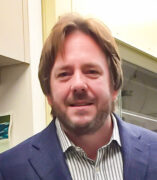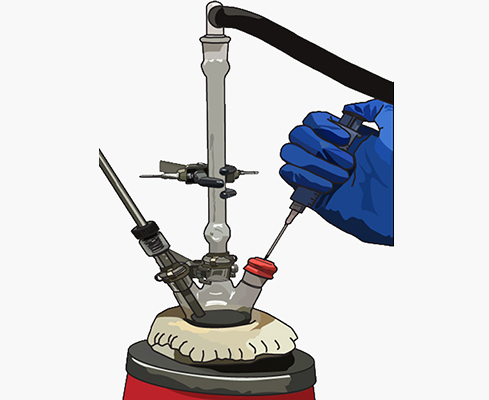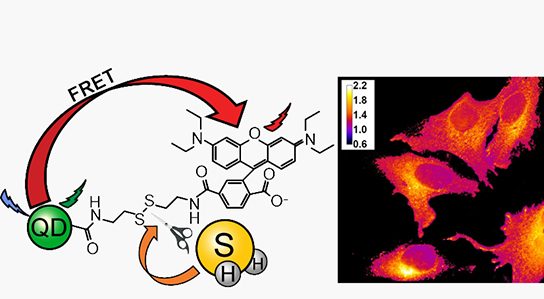
Preston Snee
Associate Professor
Chemistry
Contact
Address:
4123 SES
Office Phone:
Email:
CV Download:
Related Sites:
Intro Heading link

My research group studies how energy flows through semiconductors by synthesizing new types of quantum dots (QDs). We are interested in (1) creating systems to control the flow of energy through materials by synthetic design, (2) bandgap engineering of doped semiconductors, and (3) developing novel methods for studying semiconductor quantum dots with X-ray analyses.
Semiconductor QDs are a unique form of matter, which have a size dependent absorption and emission spectra. As a consequence, the electronic structure follows the quantum “particle-in-a-box” principal- only certain distinct electronic states can be occupied as dictated by the finite size of the crystal. Strongly confined QDs have atomic like density of states and size dependent bandgaps. Further, the crystallinity and organic surface passivation of semiconducting QDs result in very efficient emission quantum yields compared to the bulk materials. The emission wavelength can be tuned not only with size, but composition and structure as well.
Synthesis of Novel Quantum Dots Heading link

Our group uses colloidal synthesis to create new semiconductor materials. This produces QDs with sharp crystallinity with a low cost bottom-up method. Presently, we are developing very low bandgap materials, doped QDs, and multi-core/shell/shell systems with the aim of manipulating charge carrier dynamics. In this regard, we have synthesized very bright Type II QDs (Chem. Mater, 2015), low bandgap Cu3AsS4 quantum rods, (Chem. Mater, 2016), and highly emissive doped ZnSe dots (Nano Lett, 2007).
We film the synthesis of these materials and post them to our account on Youtube, such that our methods can be reproduced by a wide range of researchers.
Doped Semiconductors Heading link

Our group has developed a new way to synthesize doped semiconductors where every nanoparticle contains the same number of dopants (ACS Nano, 2013). We have followed up on this work by studying how dopant electronic states are coupled to the quantum dot band structure. We study these systems using the X-ray facilities at the Advanced Photon Source and using DFT calculations on UIC’s supercomputer cluster. Shown here is a representation of a hole localizing on a copper dopant in a photoexcited CdS quantum dot.
Energy Transfer Heading link

We have developed methods for creating conjugated chromophores- in essence we conjugate organic molecules to the surfaces of quantum dots which results in efficient Forster Resonant Energy Transfer (FRET) between the photoexcited QD and the dye. In the course of this work we discovered that we could modulate the efficiency of energy transfer when we coupled a dye which has environmentally sensitive absorption spectra. The result is a naturally self-referencing fluorescent sensor. We have used these sensors to measure oxygen and thio levels in cells, which can be used to monitor cancer metabolism.
.
Selected Publications
1) “Fluorescence Intermittency of Quantum Dot–Organic Dye Conjugates: Implications for Alternative Energy and Biological Imaging” Chandrasiri, H.; Jing, H; Perera, T.; Hu, Y. S.; Snee, P. T. J. Phys. Chem. Lett., 2023, asap.Link
2) “Nucleation Control of Quantum Dot Synthesis in a Microfluidic Continuous Flow Reactor” Kim, E.-B.; Tomczak, K.; Chandrasiri, H. B.; Pálmai, M.; Ghaznavi, A.; Gritsenko, D.; Xu, J.; Snee, P. T. Frontiers in Nanotechnology. 2022, 4. 1096267. Link
3) “Parabolic Potential Surfaces Localize Charge Carriers in Nonblinking Long-Lifetime “Giant” Colloidal Quantum Dots” Pálmai, M.; Beckwith, J. S.; Emerson, N. T.; Zhao, T.; Kim, E.-B.; Yin, S.; Parajuli, P.; Tomczak, K.; Wang, K.; Sapkota, B.; Tien, M.; Jiang, N.; Klie, R. F.; Yang H.; Snee, P. T. Nano Lett. 2022, 22, 23, 9470-9476. Link.
4) “Cytosolic delivery of membrane-penetrating QDs into T cell lymphocytes: implications in immunotherapy and drug delivery” Jing, H.; Pálmai, M.; Saed, B.; George, A.; Snee, P. T.; Hu, Y. S. Nanoscale, 2021, 13, 5519-5529. Link
5) “The Role of Colloidal Stability and Charge in Functionalization of Aqueous Quantum Dots” Snee, P. T., Accounts of Chemical Research, 2018, 51, 2949–2956. Link
6) “Charge Carriers Modulate the Bonding of Semiconductor Dopant Nanoparticles as Revealed by Time-resolved X-ray Absorption Spectroscopy” Hassan, A.; Zhang, X.; Liu, X.; Rowland, C. E.; Jawaid, A. M.; Chattopadhyay, S.; Gulec, A.; Shamirian, A.; Zuo, X.; Klie, R. F.; Schaller, R. D.; Snee, P. T. ACS Nano. 2017, 11, 10070-10076. Link
7) “Ratiometric CdSe/ZnS Nanocrystal Protein Sensor” Tyrakowski, C. M.; Snee, P. T. Anal. Chem. 2014, 86, 2380-2386. Link
8) “Cluster-Seeded Synthesis of Doped CdSe:Cu4 Quantum Dots” Jawaid, A. M.; Chattopadhyay, S.; Wink, D. J.; Page, L. E.; Snee, P. T. ACS Nano, 2013, 7, 3190–3197. Link
9) “Poly(ethylene glycol) Carbodiimide Coupling Reagents for the Biological and Chemical Functionalization of Water Soluble Nanoparticles” Shen, H.; Jawaid, A. M.; Snee, P. T. ACS Nano, 2009, 3, 915-923. Link
10) “Imparting Nanoparticle Function with Size-Controlled Amphiphilic Polymers” Chen, Y.; Thakar, R.; Snee, P. T. J. Am. Chem. Soc., 2008, 130, 3744-3745. Link
Education
- B.S., The University of North Carolina at Chapel Hill (advisor: Edward T. Samulski), 1995
- Ph.D., The University of California at Berkeley (advisor: Charles B. Harris), 2002
- Postdoctoral Fellow, Massachusetts Institute of Technology, (advisors: Moungi Bawendi and Dan Nocera), 2003-2006.
- Masters in Business Administration, Liautaud School of Business, UIC, 2016-2021.